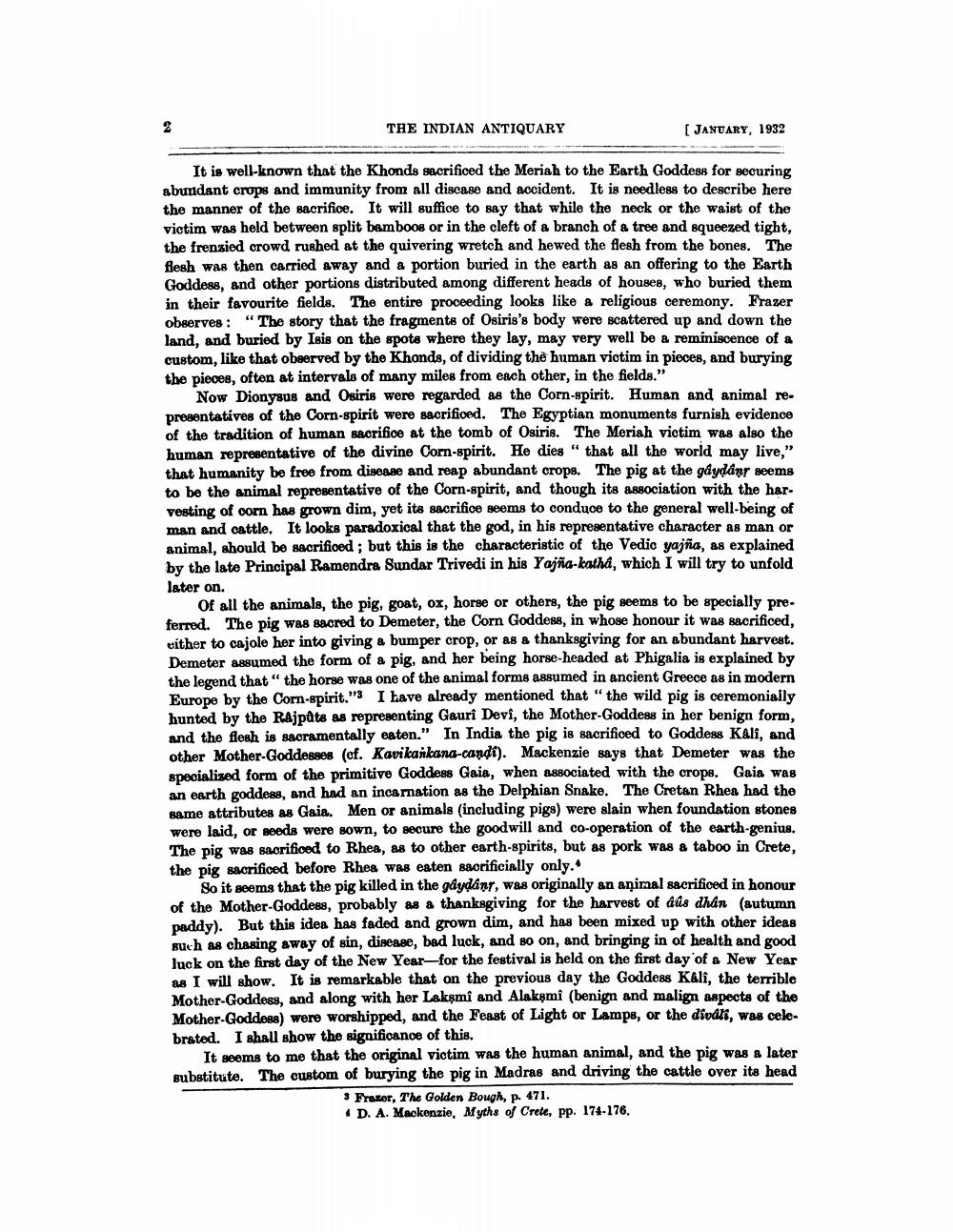Book Title: Indian Antiquary Vol 61 Author(s): Richard Carnac Temple, Charles E A W Oldham, S Krishnaswami Aiyangar, Devadatta Ramkrishna Bhandarka Publisher: Swati Publications View full book textPage 8
________________ THE INDIAN ANTIQUARY [ JANUARY, 1932 It is well-known that the Khonds sucrificed the Meriah to the Earth Goddess for securing abundant crops and immunity from all discase and accident. It is needless to describe here the manner of the sacrifice. It will suffice to say that while the neck or the waist of the victim was held between split bamboos or in the cleft of a branch of a tree and squeezed tight, the frenzied crowd rushed at the quivering wretch and hewed the flesh from the bones. The flesh was then carried away and a portion buried in the earth as an offering to the Earth Goddess, and other portions distributed among different heads of houses, who buried them in their favourite fields. The entire proceeding looks like a religious ceremony. Frazer observes: “The story that the fragments of Osiris's body were scattered up and down the land, and buried by Isis on the spots where they lay, may very well be a reminiscence of a custom, like that observed by the Khonds, of dividing the human victim in pieces, and burying the pieces, often at intervals of many miles from each other, in the fields." Now Dionysus and Osiris were regarded as the Corn-spirit. Human and animal representatives of the Corn-spirit were sacrificed. The Egyptian monuments furnish evidence of the tradition of human sacrifice at the tomb of Osiris. The Meriah victim was also the human representative of the divine Corn-spirit. He dies" that all the world may live," that humanity be free from disease and reap abundant crops. The pig at the gdydánr seems to be the animal representative of the Corn-spirit, and though its association with the har. vesting of corn has grown dim, yet its sacrifice seems to conduce to the general well-being of man and cattle. It looks paradoxical that the god, in his representative character as man or animal, should be sacrificed; but this is the characteristic of the Vedic yajña, as explained by the late Principal Ramendra Sundar Trivedi in his Yajña-katha, which I will try to unfold later on. Of all the animals, the pig, goat, ox, horse or others, the pig seems to be specially preferred. The pig was sacred to Demeter, the Corn Goddess, in whose honour it was sacrificed, víther to cajole her into giving a bumper crop, or as a thanksgiving for an abundant harvest. Demeter assumed the form of a pig, and her being horse-headed at Phigalia is explained by the legend that "the horse was one of the animal forms assumed in ancient Greece as in modern Europe by the Corn-spirit." I have already mentioned that "the wild pig is ceremonially hunted by the Rajpâts as representing Gauri Devi, the Mother-Goddess in her benign form, and the flesh is sacramentally eaten." In India the pig is sacrificed to Goddess Kali, and other Mother-Goddesses (cf. Kavikankana-candi). Mackenzie says that Demeter was the specialized form of the primitive Goddess Gaia, when associated with the crops. Gaia was an earth goddeas, and had an incarnation as the Delphian Snake. The Cretan Rhea had the same attributes as Gaia. Men or animals (including pigs) were slain when foundation stones were laid, or seeds were sown, to secure the goodwill and co-operation of the earth-genius. The pig was sacrificed to Rhea, as to other earth-spirits, but as pork was a taboo in Crete, the pig sacrificed before Rhea was eaten sacrificially only.. So it seems that the pig killed in the gáydánt, was originally an animal sacrificed in honour of the Mother-Goddess, probably as a thanksgiving for the harvest of dus dhan (autumn paddy). But this idea has faded and grown dim, and has been mixed up with other ideas such as chasing away of sin, disease, bad luck, and so on, and bringing in of health and good luck on the first day of the New Year-for the festival is held on the first day of a New Year as I will show. It is remarkable that on the previous day the Goddess Kali, the terrible Mother-Goddess, and along with her Lakşmi and Alaksmî (benign and malign aspects of the Mother-Goddess) were worshipped, and the Feast of Light or Lamps, or the divdzi, was celebrated. I shall show the significance of this. It seems to me that the original victim was the human animal, and the pig was a later substituto. The custom of burying the pig in Madras and driving the cattle over its head 3 Frazer, The Golden Bough, p. 471. # D. A. Mackenzie, Myths of Crete, pp. 174-176.Page Navigation
1 ... 6 7 8 9 10 11 12 13 14 15 16 17 18 19 20 21 22 23 24 25 26 27 28 29 30 31 32 33 34 35 36 37 38 39 40 41 42 43 44 45 46 47 48 49 50 51 52 53 54 55 56 57 58 59 60 61 62 63 64 65 66 67 68 69 70 71 72 73 74 75 76 77 78 79 80 81 82 ... 428
